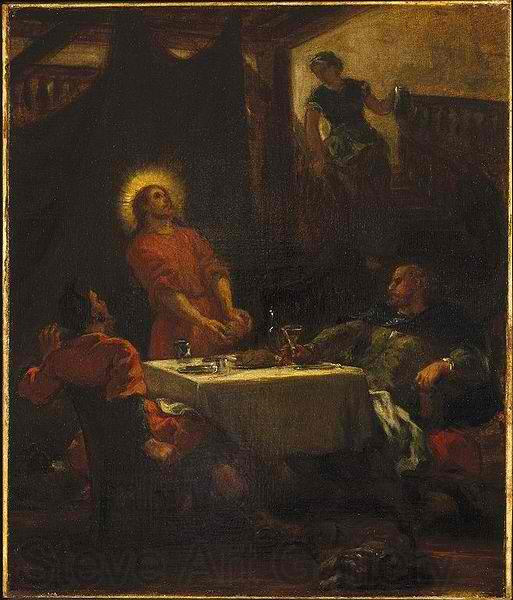
Eugène Delacroix
French, 1798-1863
The Disciples at Emmaus, 1853
Oil on canvas
21 3/4 x 18 1/2"
Brooklyn Museum, Gift of Mrs. Watson B. Dickerman
50.106
COMMENTS
The more influential critics at the Salon of 1853 were in general agreement on the quality of execution and the fine coloring of this picture; criticism centered on the lack of spirituality in the Christ and anachronism of costume and setting. In the words of Paul de Saint-Victor, who wrote a sympathetic notice, it was "a meal of colors more than a mystical banquet." Louis Peisse, while considering it the best of the three pictures Delacroix sent to the Salon, began by evoking the incomparable treatment of light in Rembrandt’s painting of the same subject in the Louvre and stressed the less ideal qualities of the Delacroix, "Mr. Delacroix has produced a charming painting of genre with an evangelical story. The Christ is, it is true to say, recognizable only because of his halo, and Mr. Delacroix seems to have followed the opinion [….] that He should have been ugly," but went on to praise the still-life objects, "we could not find and poetize these minute details done with light touch, more alive and more coquet," and concluded: "A Dutchman in the good old times would have done it differently but not better."
Delaborde severely criticized the Christ and condemned the anachronism on the grounds that a modern artist ought to know better than the Old Masters!
Horace de Viel-Castel defended the absence of spirituality in the Christ on the dubious grounds that Delacroix was here interested only in art for art’s sake.
For Henry de La Madelène, who felt no reserve, the picture itself was little short of a miracle: "This small work is a true wonder: nobility, truth, power, harmony, grace and finesse, we find all in it. The Christ is divine."
Théophile Gautier shared Peisse’s opinion that it was the best of Delacroix’s three pictures at the Salon, though he considered it to be hardly more than a sketch. He felt that it did not suffer by comparison with Rembrandt and pointed out the similarity between the winding staircase and those found in interiors of the Dutch painter, an analogy illustrated with Rembrandt’s “The Philosopher” in the Louvre.
Benesch, while finding the composition and setting "evidently inspired by the Venetians," observes a pervading influence of Rembrandt: "In [the evening gloom of the hall] the miracle acquires that silent mystical poetry which is apparent in Rembrandt’s 'Emmaus' picture in the Louvre and in his etchings."
- Lee Johnson, The Paintings of Eugène Delacroix, A Critical Catalog, v. III, Oxford, Clarendon Press, 1986, pp. 238-9
SBMA CURATORIAL LABELS
This intimately scaled painting was exhibited at the Salon of 1853 and, as usual, garnered both positive and negative commentary. Critics quickly recognized echoes of Rembrandt in the humble simplicity of this interior night-time scene, dramatically illuminated by the blazing halo of the risen Christ, whom only a few disciples have recognized. But even the usually sympathetic critic Théophile Gauthier conceded that it was little more than a sketch, while Étienne Delécleuze lamented the exaggeration of color and drawing at the expense of any resemblance to reality. Nevertheless, Delacroix readily found private collectors eager to acquire religious subjects like this one, which he produced in greater numbers throughout the 1850s.
- Delacroix and the Matter of Finish, 2013
